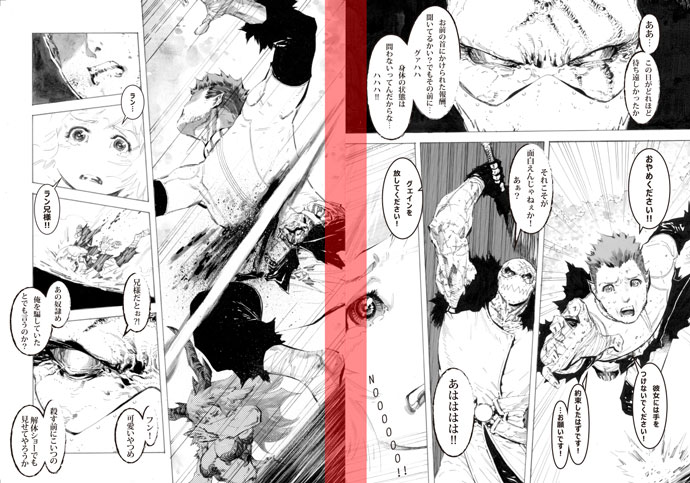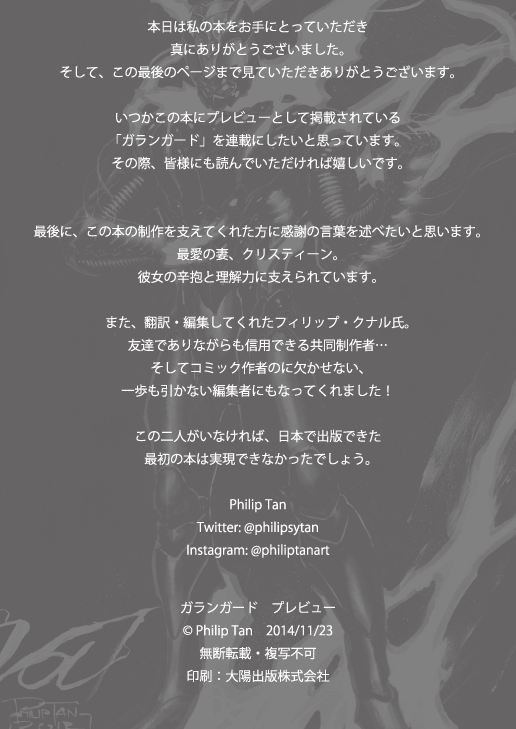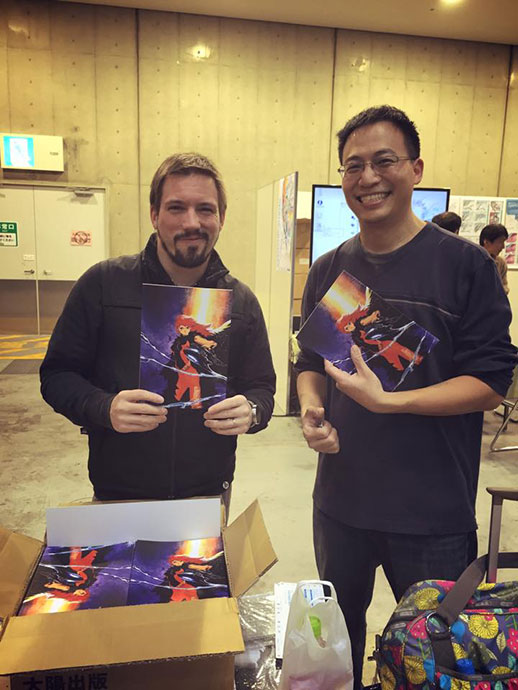As I mentioned last week, I helped out my friend Philip Tan in getting a book printed in time for International Manga Festival. I figured it might be interesting for doujinshi fans or aspiring creators to hear how it happened, so here’s a little writeup.
With thousands of publications being printed and sold, Comic Market and similar events are big business for printing agencies, and several of them have specialized in this type of book. There’s plenty of on-demand printers that will get the book to you within 4 business days, at extremely reasonable rates. We chose to go with Taiyou Shuppan, which offers packaged deals at set rates, each with a few different paper or finish options (matte or glossy, coated paper or newsprint, a few weight options, etc). Even if you don’t know anything about printing or paper material, going with the recommendations will produce a nice book unproblematically.
We opted for the “Sun Bazaar PP set”, with a 220kg matte coated 4-colour cover, and 90kg black&white interiors. The inside cover pages are usually blank in doujinshi. Possible page count runs from 12 to 300 pages (including covers), we went with 34 (9 story pages+21 sketch pages).
Printers generally accept almost every file format you’d normally use – in our case, they list Adobe Illustrator and Photoshop, Corel Painter, Comic Studio (Manga Studio), Comic Works, and PDF.
For illustrator data, I was required to create outlines for all text, flatten layers, embed images and save as eps… But I didn’t check the instructions well enough so I didn’t embed the pictures, left the layers in, and handed it in as ai files. Guess what, they accepted the data anyway. They also remarked that we should’ve numbered the pages as they would not be able to guarantee page order (remedied by writing the numbers on a printout), and helped us add a little bleed to the cover, since Philip had signed it to the far left, in the bleed area.
Philip works analog, so I had him scan the images at 600dpi at the intended print size, which we’d decided on B5 (182 × 257mm). Doujinshi are usually in B5 or A5, which is 148 × 210mm. Philip wanted the option to go edge-to-edge with his art, so we added 3mm each as bleed (188 × 263 mm in total).
I decided to letter the book in illustrator, since it helps being able to edit and resize without making the lines fuzzy or screwing things up. Scott McCloud ‘s tutorial on lettering in illustrator gave me a great entry point into the process, and most of the balloons are done in the way Scott suggests (except the ones for the villain, which felt like they needed a different brush stroke). Unfortunately I couldn’t find good custom fonts in time, so that is definitely something to keep in mind for the next one.
Note that dialogue is usually lettered vertically in Japanese, and right to left. It helps to leave a bit of additional vertical space when laying out the page. Additionally, the art or dialogue should not go too close to the “throat” of the book, so I tried to keep at least 1cm free from the inside edges. We had the book square bound (no staples), so this was extra important. (I got very, very close to failing to do this)
Doujinshi are also expected to have a section for the small print at the very end of the book, including contact info (twitter handles or websites are fine for this), copyright declaration, and (usually) the name of the printers. We included a line that says “do not reproduce without permission,” as well as a thank you message to the reader, Philip’s wife, and, well, me for helping get it done.
The printers specialized in doujinshi are extremely accommodating to artists’ needs. The deadline for data was on Tuesday morning, or even afternoon if delivered in person. Books are then scheduled to be delivered directly to the event, an immense perk of using a doujinshi-specialized printer! Payment is usually done via bank transfer, but recently a lot of places have started accepting credit cards (the one we used accepts them if you show up in person, which was very practical).
When we arrived at the venue around 10am (about an hour before the event kicked off), the books had been safely delivered directly to our booth, and were waiting beneath our table. Amazingly efficient!
If we’d opted for another printer, we would’ve had the options of carrying them ourselves (a lot of people do this with a simple wheel carrier, kind of like a suitcase without the shell), or having them sent to the temporary Yamato station at the venue – be warned, there is always a long line for this one.
For Comitia and Comiket, creators are required to hand in a sample of each book, and have it checked for content (mostly important for pornographic books). International Manga Festival does not have this requirement, so we were set to sell it right away.
Contrary to Comiket or Comitia, International Manga Festival is similar to a American or European convention. There’s plenty of publisher and retailer booths, a stage featuring panel discussions, and an “artist’s alley” area for individual artists. This area consists of plain tables for the artists to put their wares on, just like Comitia (which IMF is held in conjunction with).
Here’s a great video on International Manga Festival. I’m in there for about a second, see if you can spot me!
Our table was shared with a few other artists invited by Akihide Yanagi’s Amecomi Night, so there were some other products on the table, and signings scheduled (which enabled Philip to take some time off and wander the hall).
People started lining up to get Philip’s book right away, and there was a pretty impressive line as soon as they noticed he was also doing sketches for anyone buying the book. Setting rules for this might be a good idea before setting up.
Comitia/International Manga Festival wraps up at 4pm (yes, it’s only 5 hours), and teardown occurs incredibly fast and efficiently. You take your stuff off the table, move out, and an hour later, the hall is completely cleared out. We had a decent amount of books left, so I packed them back into one of the boxes and carried it out to the temporary Yamato station. They have shipping slips ready, but my advice would be to grab one in the morning and have it already filled out, which would enable you to skip the line for the slips after the event is over and EVERYONE needs one.
We still have some of these books left, so I am going to try to get them up for sale on Comic Zin and other doujinshi stores. I’ll make sure to put together another post about that once it’s done!
As always, make sure to let me know if you have questions, and make sure to hit the like or reblog button if you liked this post 🙂




